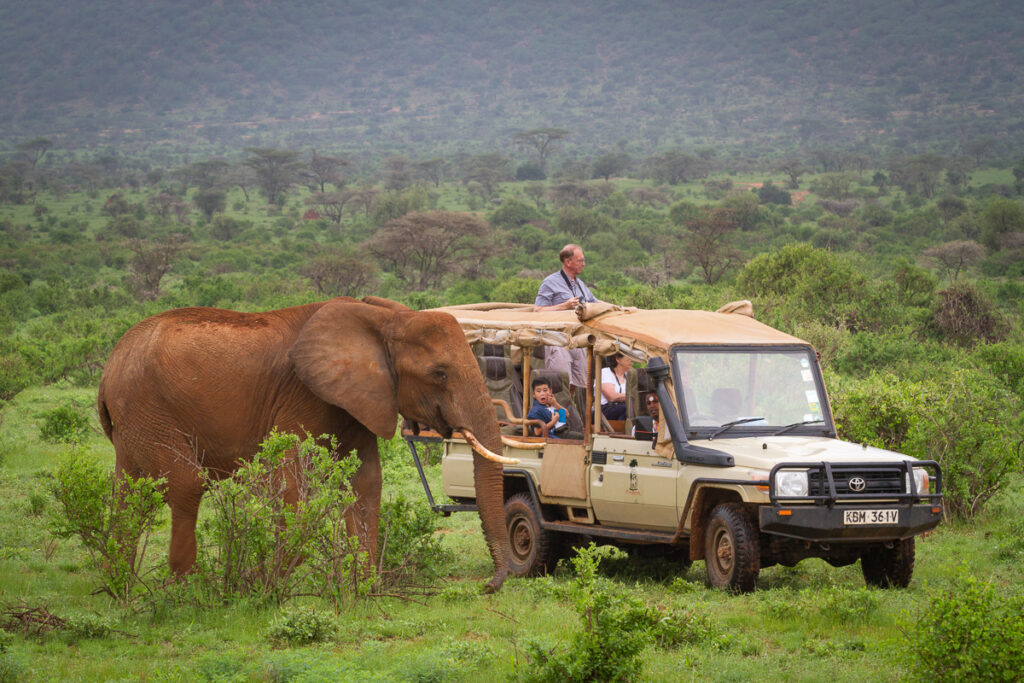Samburu National Reserve is a rugged and remote wildlife sanctuary located in the northern part of Kenya. Covering approximately 165 square kilometers, the reserve is situated on the banks of the Ewaso Ng’iro River, which serves as a lifeline for the abundant wildlife in the region. Samburu is renowned for its unique wildlife, picturesque landscapes, and rich cultural heritage of the Samburu people.
Features and Highlights
-
Unique Wildlife: Samburu is home to several species that are rare or absent in other parts of Kenya, often referred to as the “Samburu Special Five.” These include the Grevy’s zebra, Somali ostrich, reticulated giraffe, gerenuk, and Beisa oryx.
-
Ewaso Ng’iro River: The river flows through the reserve, providing a vital water source for wildlife. It attracts a variety of animals, especially during the dry season, making it a prime spot for game viewing.
-
Big Cats and Elephants: The reserve is known for its large population of elephants and healthy populations of lions, leopards, and cheetahs. These predators are frequently spotted along the riverbanks and in the open savannah.
-
Bird Watching: With over 450 bird species, Samburu is a birdwatcher’s paradise. Notable species include the vulturine guineafowl, Somali bee-eater, and the large flocks of weaver birds.
-
Scenic Landscapes: The reserve features dramatic landscapes with rolling hills, acacia woodlands, and riverine forests. The backdrop of Mount Ololokwe adds to the scenic beauty.
-
Cultural Experiences: The Samburu people, known for their distinctive culture and attire, live in the region. Visitors can learn about their traditional way of life and participate in cultural tours and village visits.
Getting There
-
By Road: Samburu National Reserve is approximately a 5-6 hour drive from Nairobi. The roads are generally in good condition, though a 4×4 vehicle is recommended for navigating the reserve.
-
By Air: There are daily scheduled flights from Nairobi’s Wilson Airport to the Samburu airstrip. The flight takes about 1 hour. Charter flights are also available.
Best Time to Visit
The best time to visit Samburu National Reserve is during the dry seasons:
- June to October: The long dry season offers excellent wildlife viewing as animals congregate around water sources.
- December to March: The short dry season is also ideal for game drives and birdwatching.
The wet seasons (April to May and November) bring lush vegetation and fewer tourists, but some roads may become difficult to navigate.





Activities
- Game Drives: Game drives are the primary activity in Samburu. Early morning and late afternoon drives are the best times for spotting wildlife. Night drives are also available in some areas.
- Bird Watching: Samburu’s diverse habitats support a wide variety of bird species, making it a prime destination for birdwatchers. Guided birdwatching tours are available.
- Cultural Visits: Visiting a Samburu village provides insights into the traditional lifestyle of the Samburu people. Cultural tours often include traditional dances, craft demonstrations, and opportunities to learn about their customs and beliefs.
- Walking Safaris: Guided walking safaris offer a chance to explore the reserve on foot, providing a closer connection to the environment and opportunities to learn about the smaller flora and fauna.
- Photography: The unique wildlife, dramatic landscapes, and vibrant culture of the Samburu people make the reserve a photographer’s dream. The river, in particular, offers stunning photographic opportunities.
- Camel Safaris: Some lodges and camps offer camel safaris, which provide a unique way to explore the landscape and view wildlife from a different perspective.
Accommodations
Samburu National Reserve offers a range of accommodation options, from luxury lodges to budget-friendly campsites:
- Luxury Lodges and Camps:
- Saruni Samburu: Located in the Kalama Conservancy, it offers luxurious accommodations with stunning views and excellent wildlife viewing opportunities.
- Samburu Intrepids Tented Camp: Situated along the river, this camp offers comfortable tents and a variety of guided activities.
- Elephant Bedroom Camp: A luxury tented camp on the banks of the Ewaso Ng’iro River, known for its close encounters with elephants.
- Mid-Range Lodges and Camps:
- Samburu Sopa Lodge: Offers comfortable accommodations and panoramic views of the surrounding landscape.
- Larsens Camp: Located along the river, this camp provides well-appointed tents and excellent service.
- Budget Campsites:
- Samburu Riverside Camp: A budget-friendly option located near the river, offering basic facilities and a great base for exploring the reserve.
- Sentrim Samburu Lodge: Offers comfortable and affordable accommodations with good facilities.
Samburu National Reserve is a remarkable destination for experiencing Kenya’s unique wildlife, breathtaking landscapes, and rich cultural heritage. Whether you’re interested in game drives, cultural experiences, or simply enjoying the serene environment, Samburu offers an unforgettable safari adventure.








